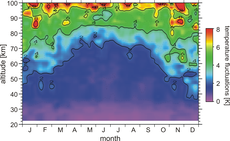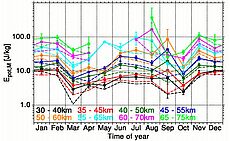Gravity wave climatology from temperature data
Middle atmosphere temperature soundings by lidars are performed regularly since many years at Kühlungsborn (54°N) and Andenes (68°N). Gravity waves show up in the data by periodic oscillations of temperature with periods of minutes to hours. Due to the regular soundings at both locations, the seasonal variation of gravity wave activity can be obtained.
Temperature fluctuations are observed at Kühlungsborn between 1 and ~105 km altitude by combination of RMR lidar and K lidar data (see left figure). Below 35 km and above 95 km only minor seasonal variations occur. In between, mainly an annual variation is observed with fluctuations being in winter about twice as large as in summer.
The gravity wave potential energy density (GWPED) can be calculated from temperature fluctuations and the (temperature-related) Brunt-Vaisala frequency. The seasonal variation of GWPED above Andenes as observed by the ALOMAR RMR lidar is shown in the right figure. Here a semi-annual variation with maxima in summer and winter is observed.
Recent observations during day and night allow simultaneous retrieval of gravity waves and tides. These waves can have similar periods, but are excited by strongly different phenomena. Wind soundings by the DoRIS system of the ALOMAR RMR lidar allow additionally the calculation of the kinetic gravity wave energy. Beside these lidars, also the mobile Fe lidar allows the observation of gravity waves in the stratosphere and mesosphere, e.g., at Davis/Antarctica. Some further information are linked in the right column.
Selected publications
- K. Baumgarten, M. Gerding und F.-J. Lübken, Seasonal variation of gravity wave parameters using different filter methods with daylight lidar measurements at mid-latitudes, J. Geophys. Res., 122, 2683-2695, doi:10.1002/2016JD025916, 2017.














